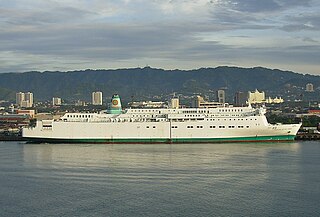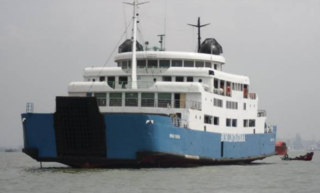
Capsizing or keeling over occurs when a boat or ship is rolled on its side or further by wave action, instability or wind force beyond the angle of positive static stability or it is upside down in the water. The act of recovering a vessel from a capsize is called righting. Capsize may result from broaching, knockdown, loss of stability due to cargo shifting or flooding, or in high speed boats, from turning too fast.
MV Bukoba was a Lake Victoria ferry that carried passengers and cargo along Tanzania's Lake Victoria between the Tanzanian ports of Bukoba and Mwanza City. MV Bukoba was built in about 1979 and had capacity for 850 tons of cargo and 430 passengers.

The MS al-Salam Boccaccio 98 was an Egyptian Ro/Ro passenger ferry, operated by El Salam Maritime Transport, that sank on 3 February 2006 in the Red Sea en route from Duba, Saudi Arabia, to Safaga in southern Egypt.

MV Ilala, formally Ilala II, is a motor ferry that has plied Lake Malawi in East Africa since 1951. Every week she crosses the lake all the way north to Chilumba, Malawi, near Tanzania and then returns to Monkey Bay. She carries both passengers and freight, and calls at major towns on both the Malawian and Mozambican coast, as well as at two islands of the lake.

The Niagara was a 245-foot (75 m) long sidewheel palace steamer launched in 1846. Like the others of its kind, it carried passengers and cargo around the North American Great Lakes. It was owned by the Collingwood Line.

MV Princess of the Stars was a passenger ferry owned by Filipino shipping company Sulpicio Lines, that capsized and sank on June 21, 2008, off the coast of San Fernando, Romblon, at the height of Typhoon Fengshen, which passed directly over Romblon as a Category 2 storm. 814 people died.

The sinking of MV Teratai Prima occurred on 11 January 2009, around 04:00 local time when a ferry carrying more than 300 people capsized in the Makassar Strait off West Sulawesi, Survivors stated that the ferry had been slammed by 4-metre (13 ft) waves twice. The first one hit so hard that the ship became unbalanced, before another wave hit from a different direction and sank the vessel.

MVDemas Victory was a Dubai-based supply ship which sailed to offshore oil and gas platforms. It capsized 10 nautical miles off the coast of the Qatari capital city of Doha on Tuesday 30 June 2009 at 6:30 a.m. local time. The disaster resulted in over 30 missing of the 35 reported to be on board. Only five were rescued, and six bodies recovered. It was feared that many of the passengers were sleeping in their cabins, and those on deck were rescued.

Shipwrecking is an event that causes a shipwreck, such as a ship striking something that causes the ship to sink; the stranding of a ship on rocks, land or shoal; poor maintenance, resulting in a lack of seaworthiness; or the destruction of a ship either intentionally or by violent weather.

On 10 September 2011, MV Spice Islander I, a passenger ferry carrying over 2,000 passengers, sank off the coast of Zanzibar. The ferry was travelling between Unguja and Pemba, two islands off the coast of mainland Tanzania, when it capsized. Early estimates put the death toll at around 200, but a report published by the Tanzanian government in January 2012 claimed that over 1,500 people had been killed.

Gallinipper was a schooner that sank in Lake Michigan off the coast of Centerville, Manitowoc County, Wisconsin, United States. In 2010, the shipwreck site was added to the National Register of Historic Places.

The ferry MV Sewol sank on the morning of April 16, 2014, en route from Incheon towards Jeju in South Korea. The 6,825-ton vessel sent a distress signal from about 2.7 kilometres north of Byeongpungdo at 08:58 KST. Out of 476 passengers and crew, 304 died in the disaster, including around 250 students from Danwon High School in Ansan City. Of the 172 survivors, more than half were rescued by fishing boats and other commercial vessels that arrived at the scene approximately 40 minutes before the Korea Coast Guard (KCG).
MV Dongfang zhi Xing was a river cruise ship that operated in the Three Gorges region of inland China. On the night of 1 June 2015, the ship was traveling on the Yangtze River when it capsized during a thunderstorm in Jianli, Hubei Province with 454 people on board. On 13 June, 442 deaths were confirmed, with 12 survivors. The passengers were mostly in their 60s and 70s, and mostly from Nanjing, where the ship started its cruise.

MV Nyerere is a Tanzanian ferry that capsized on 20 September 2018 while travelling between the islands of Ukerewe and Ukara on Lake Victoria. The Tanzanian government have declared that 228 people died as a result of the capsizing while 41 could be rescued. The capsized ferry was successfully righted, retrieved and unloaded more than one week after the disaster.

The sinking of MV Acita 03 occurred on the night of 18 October 2007 when a ferry carrying 174 passengers and crews accidentally capsized during its docking in Baubau, Southeast Sulawesi. 134 passengers and crews survived the disaster while 30 passengers and 1 crew member lost their lives. 9 people were listed as missing and presumed dead.

MV. Windu Karsa was an Indonesian-flagged double-ended RO/RO ferry that served the route from Luwu, South Sulawesi to Kolaka, Southeast Sulawesi. Built in Fujiwara Shipyard in 1980, she has served in Indonesia for more than 20 years.













